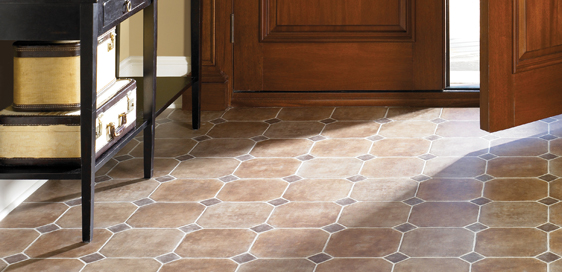The second most desirable quality in a floor – after pattern and color – is easy care maintenance. If you have ever swept a floor that has seams or gaps, you quickly realized that these cracks are the bane of floor maintenance. Especially in the kitchen and dining areas, crumbs and dirt inevitably find their way into them, darkening them over time. But this is not just a modern-day problem.

Back in the early 1700’s colonial homes typically had wide plank wood flooring throughout. In the attempt to prevent crumbs from falling off the table and filling the natural gaps in the floor, squares of cloth known as “floor sheets” were laid underneath the table. Later, this became more refined as easier to clean h3er materials like hemp and oil canvas replaced the cloth sheet. The natural progression, of course, led to the invention of sheet linoleum flooring in the late 1800s. In the 1950s, sheet vinyl took center stage as the seamless floor covering of choice for the kitchen floor. The clear vinyl protective coating of sheet vinyl made for very vibrant colors – more vibrant than linoleum, the standard floor covering of the day.
Although linoleum has stayed pretty much the same in the way it is manufactured, sheet vinyl has made some improvements. A sheet vinyl floor product is basically four layers of material – a backing, a print layer, and wear layer, and a urethane topcoat. Advances in digital imaging have improved the print layer to closely resemble the natural product they are replicating – often wood or stone. The backing material which was traditionally made of felt or a compressed paper/calcium carbonate product, has been replaced by a fiberglass woven product that still provides the cushion of resilient flooring, except with added strength. The bottom line: sheet vinyl flooring is much improved today since the 1980s.
There is only one factor to consider when it comes to quality in a flooring product; that is how well the flooring wears. You want to get as many years as possible out of your flooring investment. Sheet vinyl flooring typically comes in two thicknesses: thinner flooring at 10 to 15 mil, and professional-grade flooring – which is generally 20 to 25 mil thick. To the do-it-yourselfer, the thinner product is much easier to work with and also less expensive. But in the long haul, the thicker vinyl sheet flooring will outlast the thinner brands. When buying vinyl flooring, pay special attention to the “wear layer” thickness.
Any resilient flooring can be susceptible to tears. It is the nature of resilient floors to give and flex. A better quality product will stand up better to potential tears, especially if it has the fiberglass fabric backing. If you are concerned about tearing, consider installing luxury vinyl tile instead. In the event of a tear, is easy to repair by simply replacing the torn tile.
It goes without saying that even the most expensive product can look terrible with a poor installation job. Resilient flooring has a knack for showing defects in the sub-floor. If you are not confident enough to install a sheet vinyl floor yourself, consider getting a quote from Cardoza Flooring’s installation crew. In the long run, it will be worth it!